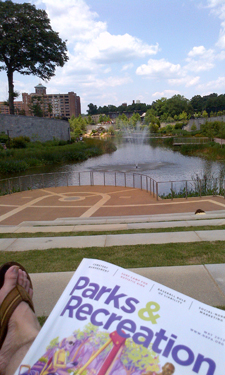 The Historic Fourth Ward Park in northeast Atlanta consists of 17 acres of new park where there once stood little more than cracked asphalt and trash-strewn fields. Designed primarily to slow and hold stormwater and to prevent flooding of downstream sites, the core of the Historic Fourth Ward Park includes open lawns for passive recreation, a playground, a spraypad, an outdoor amphitheater and a two-acre lake.
The Historic Fourth Ward Park in northeast Atlanta consists of 17 acres of new park where there once stood little more than cracked asphalt and trash-strewn fields. Designed primarily to slow and hold stormwater and to prevent flooding of downstream sites, the core of the Historic Fourth Ward Park includes open lawns for passive recreation, a playground, a spraypad, an outdoor amphitheater and a two-acre lake.
The lake provides a beautiful and visually arresting setting, but also serves a functional purpose as a flood detention basin in times of storms. In this role, the lake increases the sewer capacity, reducing the burden on aging city infrastructure and minimizing downstream flooding and property damage. This “green infrastructure” project ultimately saved the city more than $15 million in construction costs versus a traditional stormwater tunnel system. Planned with long-term sustainability in mind, it uses elements such as native plants, energy-efficient lighting, water-conserving irrigation systems and other features to reduce maintenance costs and improve sustainability.
Dedicated by Mayor Kasim Reed in June 2011 and maintained by the City of Atlanta’s Department of Parks and Recreation, the Historic Fourth Ward Park has spurred community revitalization and economic development with more than $400 million in new development currently underway in the neighborhood surrounding the park. The stormwater detention basin and other green infrastructure improvements have worked so well that it has sparked new downstream redevelopment, including the two-million-square-foot Ponce City Market being built in a repurposed warehouse that regularly flooded before the stormwater control improvements were made.
Learn about NRPA's Green Infrastructure Evaluation Framework.

